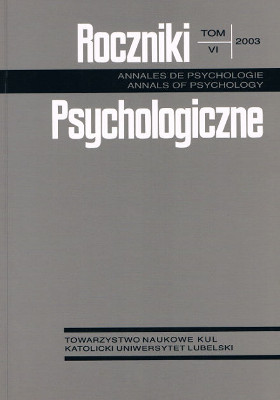Cechy osobowości i obraz siebie pacjentek z jadłowstrętem psychicznym (anorexia nervosa)
Abstrakt
The paper seeks to answer the question what personalities, personality traits, are connect with anorexia nervosa. In the beginning the paper characterizes anorexia as a disorder together with the descriptions of female personalities that we find in literature. In the test the Adjective Check List ACL by H. G. Gough and A. B. Heilbrun has been used in its Polish translation and adaptation by Z. Płużek. The respondents filled it in its „I am” version. The group of female patients with anorexia consisted of 50 girls (the diagnosis of anorexia in conformity with ICD-10), aged 15-27. The control group consisted of 50 healthy girls (no diagnosis of anorexia or any other psychiatric diagnosis), aged 15-28. The test was carried out in the period of two years 2000/2001. The findings point to statistically essential differences (p≤0, 005) with regard to some dimensions of self-image between anorectic patients and healthy people. Anorectic female patients obtained lower results in the following subscales of the test: Fav, Nur, Aff, Het, Exh, S-Cfd, P-Adj, Iss, Np, A-3. Essentially higher results for this group have been obtained in the following subscales: Aba, Crs, Ac, A-2. As regards the mean results in scales ACL, a profile of personality characteristic of anorectic patients has been presented. In the discussion, the results of the study have been compared with the results of other authors. On the basis of the analyses one may conclude that there are certain personality traits characteristic of anorectic patients: low self-assessment, criticism, self-control, persistence in accomplishing a goal, an ability to plan and organize actions, difficulties in establishing and maintaining steady ties with other people, sensitivity, and lack of self-confidence. The findings may serve as hints to search new solutions in therapeutic work and attempts to work out therapeutic steps.
Bibliografia
Banaś, A., Januszkiewicz-Grabias, A., Radziwiłłowicz, P. (1998). Wieloczynnikowe uwarunkowania zaburzeń odżywiania się. Psychiatria Polska, 32, 2, 165-176
Bemporad, J. R., Beresin, E., Ratey, J. J., O'Driscoll, G., Lindem, K., Herzog, D. B. (1992). A psychoanalytic study of eating disorders: I. A developmental profile of 67 index cases. Journal of the American Academy of Psychoanalysis, 20, 4, 509-531.
Bruch, H. (1973). Eating disorder. New York: Basic Books.
Butow, P., Beumont, P., Touyz, S. (1993). Cognitive processes in dieting disorders. International Journal of Eating Disorders, 14, 3, 319-239.
Cachelin, F. M., Maher, B. A. (1998). Is amenorrhea a critical criterion for anorexia nervosa? Journal of Psychosomatic Research, 44, 3-4, 435-440.
Drwal, R. Ł. (red.) (1989). Techniki kwestionariuszowe w diagnostyce psychologicznej: wybrane zagadnienia. Lublin: UMCS.
Drwal, R. Ł. (1995). Adaptacja kwestionariuszy osobowości. Warszawa: Wydawnictwo Naukowe PWN.
Fairburn, C. G., Szafran, R., Cooper, Z. (1999). A cognitive behavioral theory of anorexia nervosa. Journal of Psychosomatic Research, 37, 1, 1-13.
Gothelf, D., Apter, A., Ratzoni, G., Orbach, I., Weizman, R., Tyano, S., Pfeffer, C. (1995). Defense mechanisms in severe adolescent anorexia nervosa. Journal of the American Academy of Child and Adolescent Psychiatry, 174, 89-90.
Jones, E., Watson, J. P. (1997). Delusion, the overvalued idea and religious beliefs: A comparative analysis of their characteristics. British Journal of Psychiatry, 170, 381-386.
Lopez-Seco, F., Rodriguez-Del-Toro, C. (1999). Associated factors to the cronicity in eating disorders. Anales-de-Psiquiatria, 15, 4, 137-144.
Łaguna, M. (1996). Budować obraz siebie. Lublin: TN KUL.
Namysłowska, I., Paszkiewicz, E., Siewierska, A. (2000). Gdy odchudzanie jest chorobą. Anoreksja i bulimia. Warszawa: WAB.
O'Silverstone, P. H. (1992). Is chronic low self-esteem the cause of eating disorders? Medical Hypotheses, 39, 4, 311-315.
Palmer, R. L., Treasure, J. (1999). Providing specialized serviced for anorexia nervosa. British Journal of Psychiatry, 175, 306-309.
Pryor, T., Wiederman, M. W. (1996). Measurement of nonclinical personality characteristics of women with anorexia nervosa or bulimia nervosa. Journal of Personality Assessment, 67, 2, 414-421.
Pużyński, S. (1993). Leksykon psychiatrii. Warszawa: Państwowy Zakład Wydawnictw Lekarskich.
Rajewski, A., Talarczyk-Więckowska, (1996). Poziom intelektu, aspiracji i samoakceptacji u chorych z restrykcyjną i bulimiczną postacią jadłowstrętu psychicznego. Psychiatria Polska, 30, 5, 811-820.
Ramsay, R., Ward, A., Treasure, J., Russel, G. F. M. (1999). Compulsory treatment in anorexia nervosa. British Journal of Psychiatry, 175, 147-153.
Sulestrowska, H. (1989). Wybrane zagadnienia psychiatrii dziecięcej. W: T. Bilikiewicz, Psychiatria kliniczna. Warszawa: Państwowy Zakład Wydawnictw Lekarskich, s. 332-336.
Śpila, B., Grzywa, A., Karakuła, H., Kosińska, U., Makara, M. (1997). Porównanie obrazu własnego „ja” i samoakceptacji u chorych na schizofrenię paranoidalną i nerwicę. Psychiatria Polska, 31, 3, 269-284.
Wandokanty-Bocheńska, M. (1994). Analiza czynników psychologicznych wpływających na powstanie jadłowstrętu psychicznego punktem wyjścia do stworzenia modelu terapii. Pediatria Polska, 59, 6, 463-466.
Włodarczyk-Bisaga K. (1993). Zaburzone postawy i zachowania wobec odżywiania się wśród uczniów szkół licealnych, studentek oraz robotnic (mps pracy doktorskiej, Biblioteka Instytutu Psychiatrii i Neurologii w Warszawie).
Vitousek, K., Manke, F. (1994). Personalisty variables and disorders in anorexia nervosa and bulimia nervosa. Journal of Abnormal Psychology, 103, 1, 137-147.
The ICD-10 Classification of Mental and Bahavioural Disorders (1992). World Health Organization Geneva.
Copyright (c) 2003 Roczniki Psychologiczne

Utwór dostępny jest na licencji Creative Commons Uznanie autorstwa – Użycie niekomercyjne – Bez utworów zależnych 4.0 Międzynarodowe.


